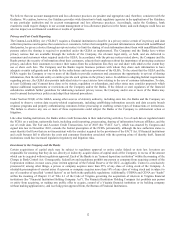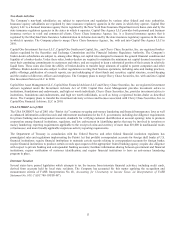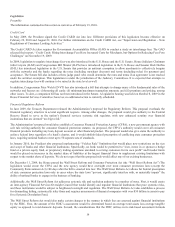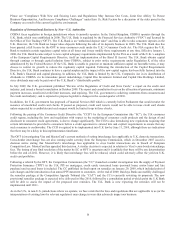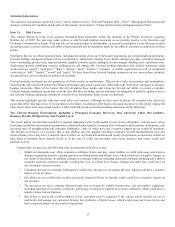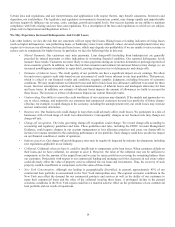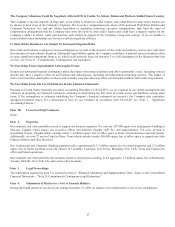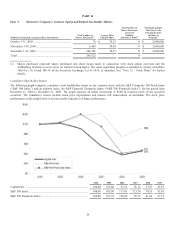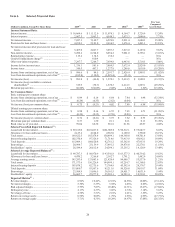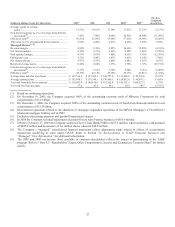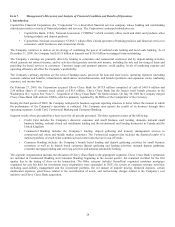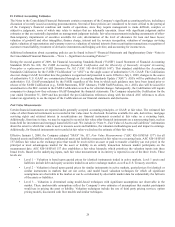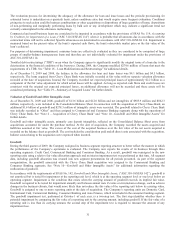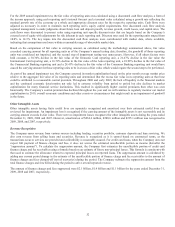Capital One 2009 Annual Report Download - page 35
Download and view the complete annual report
Please find page 35 of the 2009 Capital One annual report below. You can navigate through the pages in the report by either clicking on the pages listed below, or by using the keyword search tool below to find specific information within the annual report. 22
Likewise, adverse developments affecting the overall strength and soundness of our competitors or the financial services industry as a
whole could have a negative impact on perceptions about the strength and soundness of our business even if we are not subject to the
same adverse developments. In addition, adverse developments with respect to third parties with whom we have important
relationships also could negatively impact perceptions about us. These perceptions about us could cause our business to be negatively
affected and exacerbate the other risks that we face.
Reputational Risk And Social Factors May Impact Our Results
Our ability to originate and maintain accounts is highly dependent upon the perceptions of consumer and commercial borrowers and
deposit holders and other external perceptions of our business practices and/or our financial health. Adverse perceptions regarding our
reputation in the consumer, commercial and funding markets could lead to difficulties in generating and maintaining accounts as well
as in financing them. Particularly, negative perceptions regarding our reputation could lead to decreases in the levels of deposits that
consumer and commercial customers and potential customers choose to maintain with us.
In addition, a variety of social factors may cause changes in borrowing activity, including credit card use, payment patterns and the
rate of defaults by accountholders and borrowers domestically and internationally. These social factors include changes in consumer
confidence levels, the public’s perception regarding consumer debt, including credit card use, and changing attitudes about the stigma
of personal bankruptcy. If consumers develop negative attitudes about incurring debt or if consumption trends continue to decline, our
business and financial results will be negatively affected.
We Face Intense Competition in All of Our Markets
We operate in a highly competitive environment, and we expect competitive conditions to continue to intensify. In such a competitive
environment, we may lose entire accounts, or may lose account balances, to competing financial institutions, or find it more costly to
maintain our existing customer base. Customer attrition from any or all of our lending products, together with any lowering of interest
rates or fees that we might implement to retain customers, could reduce our revenues and therefore our earnings. Similarly, customer
attrition from our deposit products, in addition to an increase in rates and/or services that we may offer to retain those deposits, may
increase our expenses and therefore reduce our earnings. We expect that competition will continue to increase with respect to most of
our products. Some of our competitors may be substantially larger than we are, which may give those competitors advantages,
including a more diversified product and customer base, the ability to reach out to more customers and potential customers,
operational efficiencies, more versatile technology platforms, broad-based local distribution capabilities, lower-cost funding, and
larger existing branch networks. In addition, some of our competitors may not be subject to the same regulatory requirements or
legislative scrutiny to which we are subject, which also could place us at a competitive disadvantage.
Fluctuations In Market Interest Rates Or The Capital Markets Could Adversely Affect Our Revenue And Expense, The Value
Of Assets And Obligations, Our Cost Of Capital Or Our Liquidity
Like other financial institutions, our business may be sensitive to market interest rate movement and the performance of the financial
markets. Changes in interest rates or in valuations in the debt or equity markets could directly impact us. First, we borrow money from
other institutions and depositors, which we use to make loans to customers and invest in debt securities and other earning assets. We
earn interest on these loans and assets and pay interest on the money we borrow from institutions and depositors. Fluctuations in
interest rates, including changes in the relationship between short term rates and long term rates and in the relationship between our
funding basis rate and our lending basis rate, may have negative impacts on our net interest income and therefore our earnings. In
addition, interest rate fluctuations and competitor responses to those changes may effect the rate of customer pre-payments for
mortgage, auto and other term loans and may affect the balances customers carry on their credit cards. These changes can reduce the
overall yield on our earning asset portfolio. Changes in interest rates and competitor responses to these changes may also impact
customer decisions to maintain balances in the deposit accounts they have with us. In addition, changes in valuations in the debt and
equity markets could have a negative impact on the assets we hold in our investment portfolio. Finally, such market changes could
also have a negative impact on the valuation of assets for which we provide servicing.
We assess our interest rate risk by estimating the effect on our earnings under various scenarios that differ based on assumptions about
the direction and the magnitude of interest rate changes. We take risk mitigation actions based on those assessments. We face the risk
that changes in interest rates could reduce our net interest income and our earnings in material amounts, especially if actual conditions
turn out to be materially different than those we assumed.
See Item 7 “Management’s Discussion and Analysis of Financial Condition and Results of Operations—Interest Rate Risk” for
additional information.


